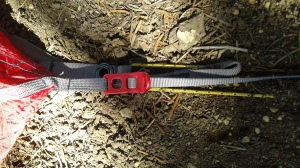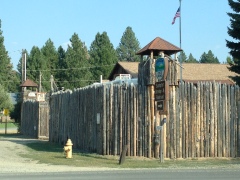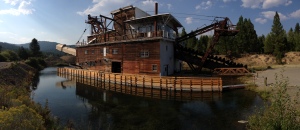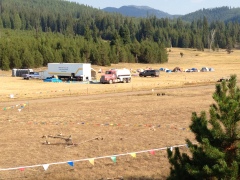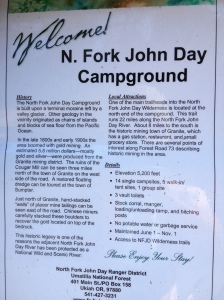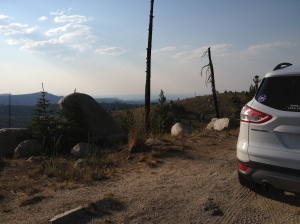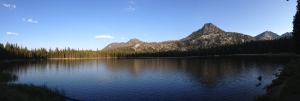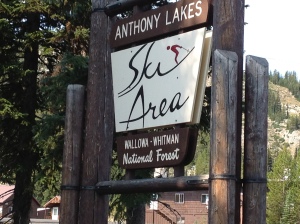I’m the proud owner of a brand new Mountain Safety Research – MSR Hubba Hubba NX ultralightweight backpacking tent! With 27-year-low snowpack in Oregon’s Cascade Mountains, I couldn’t wait to try out my new tent. I also bought the “Gear Shed” attachment for the tent. So, I headed up to Clear Lake near Mount Hood, Oregon to set up and sleep in my new tent.
The MSR Hubba Hubba NX is a super light two-person tent – only 3.7 pounds! But any tent I’m going to be pleased using has to be easy to set up and durable. And on warm summer nights I like to set up the tent without the fly. This allows for star gazing and cooler sleeping. But some tents have a very shallow “bathtub” around the bottom, allowing breezes to get through, and onlookers to see you when you’re dressing. I like tents where the “bathtub” is a bit higher.
As a backpacker and kayak camper, I also want a tent that’s easy to set up in the dark. No complicated setups. I also like tents with reflectors so at night I can shine a light on them and see it from far away. Gear vestibules are also super important. I want my shoes and gear to stay dry even if it’s outside my mosquito-lined sleeping area. For windy days tents need to be guyed out. There must be ways to secure the tent to the ground, so it doesn’t blow away.
So with these needs / wants in mind I set about testing and setting up the MSR Hubba Hubba NX. Unpacking it from the bag, I immediately noticed thoughtful touches. The bag kind of cinches up like a cradle. The bag has outside straps enabling it to be scrunched down like a compression sack.
I set out the tent footprint and then laid the tent on top of it. I staked out the corners. Right away I noticed a clever detail where the attachment of the tent to the stakes takes place. A sturdy cinchable strap-to-stake attachment point. Nice!
I unpacked the tent frame. On the MSR Hubba Hubba NX there is only one frameset where all the pieces are connected via shock cord. It’s made of DAC Pressfit aluminum. Light and durable. But you need to be careful and deliberate about connecting. I fear splitting a pole end if I am in a hurry.
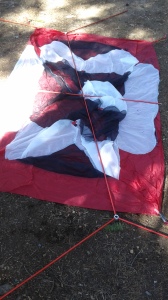 I laid the frame on top of the staked-out tent.
I laid the frame on top of the staked-out tent.
The next step is to connect all four corners and the top center piece to the frame. It’s a little challenging do do alone but with practice it will be easy.
OK. So now, the next step will be snapping the clips to the frame.
It’s here I notice another thoughtful and durable touch.
The clips are shaped to fit snugly around the poles, but there is more. The load of the clip is spread between two attachment points on the tent. This reduces stress points on the stitching on the tent.
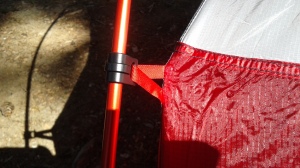 So far, I’m delighted with the thoughtful, clever details of this tent. And all for 3.7 pounds! Next step is to connect the clips. Once done I’ll have the full volume of the inside.
So far, I’m delighted with the thoughtful, clever details of this tent. And all for 3.7 pounds! Next step is to connect the clips. Once done I’ll have the full volume of the inside.
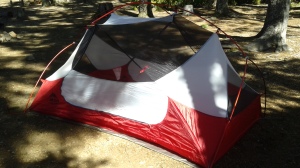 This is how nights under the stars will be. This is how I like things – there is a good view of the sky above, and ample ventilation – but the bathtub walls are high enough to shield occupants from wind and from onlookers.
This is how nights under the stars will be. This is how I like things – there is a good view of the sky above, and ample ventilation – but the bathtub walls are high enough to shield occupants from wind and from onlookers.
Next, the fly. A fly should be able to keep rain out but also allow for ventilation – and especially bonus points are awarded for flies that can be unzipped without rain dripping into the tent.
 Voila. with the fly attached, and the vestibules stakes out, there is actually a lot of acreage to store packs and shoes out of rain’s way. Two tent mates each have a vestibule and exit for themselves. Inside the tent, on each end, there are tent-wide gear pockets. Enough for most any backpacker’s needs. Up above, there are attachment points so you can sling strings – from which you can dry your stanky socks. Unfortunately two things are lacking – Firstly, a distinct shortage of attachment points for guy lines and secondly, no reflective piping.
Voila. with the fly attached, and the vestibules stakes out, there is actually a lot of acreage to store packs and shoes out of rain’s way. Two tent mates each have a vestibule and exit for themselves. Inside the tent, on each end, there are tent-wide gear pockets. Enough for most any backpacker’s needs. Up above, there are attachment points so you can sling strings – from which you can dry your stanky socks. Unfortunately two things are lacking – Firstly, a distinct shortage of attachment points for guy lines and secondly, no reflective piping.
But let’s say you have need for even more room. You have a disagreement with your tent mate. Or perhaps there is a 3rd soul needing a place to rest for the night. Or you’re car camping with executive camping gear and you’re needing extra storage space. For that, the MSR Hubba Hubba NX offers a solution: The Gear Shed.
The Gear Shed doubles the available storage space. Or can be used to accommodate another camper – or a Man’s Best Friend? If you have the MSR Gear Shed, you have options.
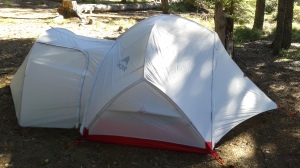 What’s the verdict? Well, although I love this tent and gear shed setup, it’s not 100% perfect. Somehow designers left out reflective materials. At night I bumped the corners more than once. And I have to wonder about its ability to hold up in the wind without lots of guy line attachment points. Still, I love the MSR Hubba Hubba NX and it’s a keeper. I can recommend it!
What’s the verdict? Well, although I love this tent and gear shed setup, it’s not 100% perfect. Somehow designers left out reflective materials. At night I bumped the corners more than once. And I have to wonder about its ability to hold up in the wind without lots of guy line attachment points. Still, I love the MSR Hubba Hubba NX and it’s a keeper. I can recommend it!

